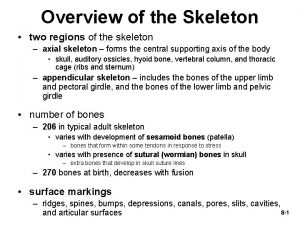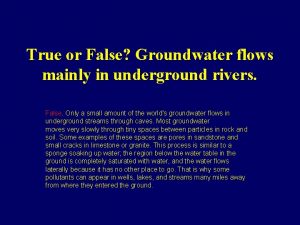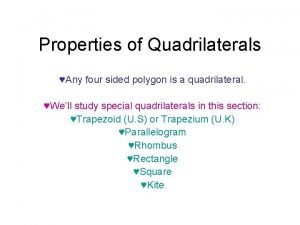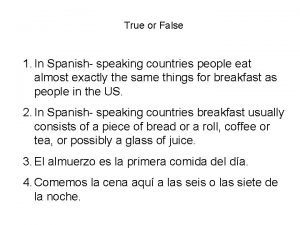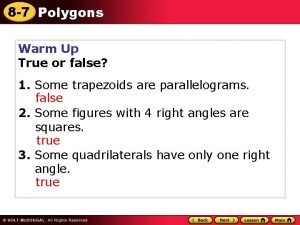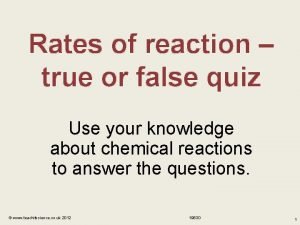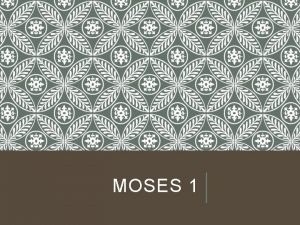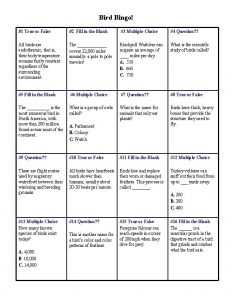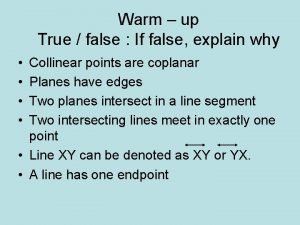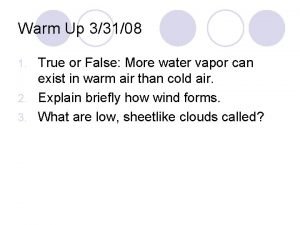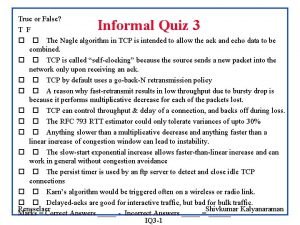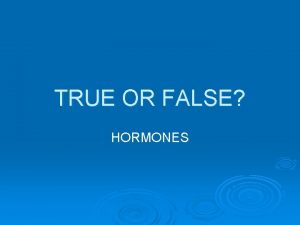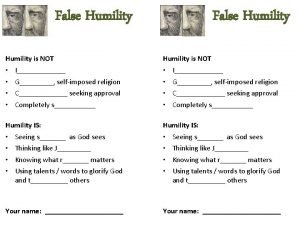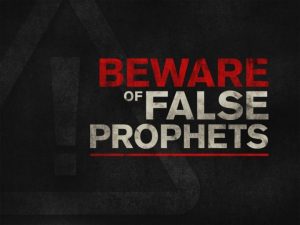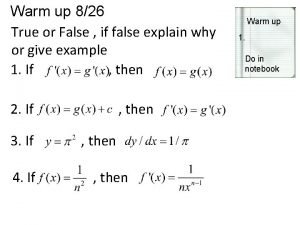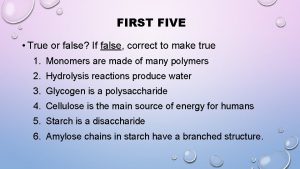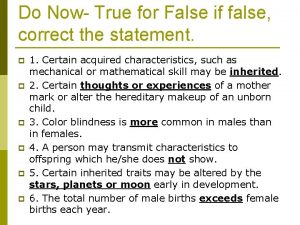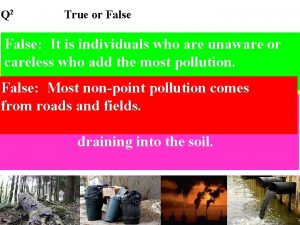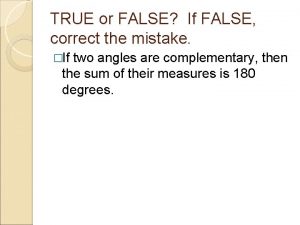Diversity Test Review Part A True and False




































































































































- Slides: 132

Diversity Test Review

Part A: True and False

All organisms are currently classified in one of five kingdoms. A. True B. False

All organisms are currently classified in one of five kingdoms. A. True B. False - six kingdoms

Bacteria and protists are eukaryotes. A. True B. False

Bacteria and protists are eukaryotes. A. True B. False - protists are eukaryotes

Viruses are not classified as living organisms. A. True B. False

Viruses are not classified as living organisms. A. True B. False

The system of using a two-word name for each species is called trinomial nomenclature. A. True B. False

The system of using a two-word name for each species is called trinomial nomenclature. A. True B. False - binomial nomenclature

Archaea is a phylum of prokaryotes that live in extreme environments. A. True B. False

Archaea is a phylum of prokaryotes that live in extreme environments. A. True B. False - Archaea is a Kingdom

Round bacteria are called bacilli. A. True B. False

Round bacteria are called bacilli. A. True B. False - coccus

Gram positive bacteria have thick cell walls and stain purple with Gram stain. A. True B. False

Gram positive bacteria have thick cell walls and stain purple with Gram stain. A. True B. False

Chemoautotrophs obtain energy by breaking apart chemical bonds in inorganic compounds. A. True B. False

Chemoautotrophs obtain energy by breaking apart chemical bonds in inorganic compounds. A. True B. False

Bacterial cells can divide by mitosis but not meiosis. A. True B. False

Bacterial cells can divide by mitosis but not meiosis. A. True B. False - bacterial cells divide by binary fission

Bacteria reproduce sexually by a process called conjugation. A. True B. False

Bacteria reproduce sexually by a process called conjugation. A. True B. False

Protozoa are heterotrophic protists. A. True B. False

Protozoa are heterotrophic protists. A. True B. False

Fungi are multicellular autotrophs. A. True B. False

Fungi are multicellular autotrophs. A. True B. False - multicellular heterotrophs

The diploid generation of a plant is called the gametophyte. A. True B. False

The diploid generation of a plant is called the gametophyte. A. True B. False - sporophyte

Mosses, Liverworts and Ferns are all examples of non-vascular plants. A. True B. False

Mosses, Liverworts and Ferns are all examples of non-vascular plants. A. True B. False - ferns are vascular

Platyhelminthes have three layers of cells and no coelom. A. True B. False

Platyhelminthes have three layers of cells and no coelom. A. True B. False

Annelids have three layers and no coelom. A. True B. False

Annelids have three layers and no coelom. A. True B. False - annelids have a coelom

Squids and cuttlefish are examples of crustaceans, which are a subgroup of arthropods. A. True B. False

Squids and cuttlefish are examples of crustaceans, which are a subgroup of arthropods. A. True B. False - mollusks

The animal represented is an example of a chordate. A. True B. False

The animal represented is an example of a chordate. A. True B. False

Part B: Multiple Choice

Bacteria a. can only reproduce asexually b. occur in three shapes - round, cube and spiral c. may be autotrophs or heterotrophs d. are eukaryotes e. are commonly known as "extremophiles"

Bacteria a. can only reproduce asexually b. occur in three shapes - round, cube and spiral c. may be autotrophs or heterotrophs d. are eukaryotes e. are commonly known as "extremophiles"

Diatoms a. have a rigid cell walls with an outer layer of silica b. have two flagella c. are mainly fresh-water organisms d. are prokaryotes e. increase in size at each generation

Diatoms a. have a rigid cell walls with an outer layer of silica b. have two flagella c. are mainly fresh-water organisms d. are prokaryotes e. increase in size at each generation

A fungus is an example of a a. photoautotroph b. chemoautotroph c. photoheterotroph d. chemoheterotroph e. none of the above

A fungus is an example of a a. photoautotroph b. chemoautotroph c. photoheterotroph d. chemoheterotroph e. none of the above

Mushrooms a. are the basidiocarps of club fungi b. produce spores c. are made of compacted hyphae d. all of the above

Mushrooms a. are the basidiocarps of club fungi b. produce spores c. are made of compacted hyphae d. all of the above

Conifers a. have small, inconspicuous flowers b. produce spores c. are examples of bryophytes d. are examples of gymnosperms e. have co-evolved with specialized pollinators such as insects

Conifers a. have small, inconspicuous flowers b. produce spores c. are examples of bryophytes d. are examples of gymnosperms e. have co-evolved with specialized pollinators such as insects

Jellyfish are in the phylum a. Porifera b. Cnidaria c. Platyhelminthes d. Gnetophyta e. Cephalochordata

Jellyfish are in the phylum a. Porifera b. Cnidaria c. Platyhelminthes d. Gnetophyta e. Cephalochordata

Arthropods have a. eight legs b. a hard exoskeleton c. no coelom d. a single body layer e. ten legs

Arthropods have a. eight legs b. a hard exoskeleton c. no coelom d. a single body layer e. ten legs

Part C: Matching

Match the term or organism with the correct Kingdom Term / Organism Kingdom 1. Rhizopus mycelium a. Archaea 2. Prothallus b. Bacteria 3. Halophile c. Protista 4. Capsule d. Fungi 5. Mesoderm e. Plantae 6. Diatoma vulgaris f. Animalia 7. Coelom 8. Penicillium

Match the term or organism with the correct Kingdom Term / Organism Kingdom 1. Rhizopus mycelium - d a. Archaea 2. Prothallus - e b. Bacteria 3. Halophile - a c. Protista 4. Capsule - b d. Fungi 5. Mesoderm - f e. Plantae 6. Diatoma vulgaris - c f. Animalia 7. Coelom - f 8. Penicillium - d

Part D: Short Answer

1. What is a halophile, and where would you look for one?

1. What is a halophile, and where would you look for one? Halophile - A salt loving organism and would be found in a salt pool.

What is the main difference between a eukaryote and a prokaryote?

What is the main difference between a eukaryote and a prokaryote? Prokaryotes DO NOT have an organized nucleus.

List the four phylum of protozoa.

List the four phylum of protozoa. a. Cercazoa

List the four phylum of protozoa. a. Cercazoa b. Sporozoa

List the four phylum of protozoa. a. Cercazoa b. Sporozoa c. Ciliaphora

List the four phylum of protozoa. a. b. c. d. Cercazoa Sporozoa Ciliaphora Zoomastigia

Describe how the following protists move. a. b. c. d. Cercozoa Sporozoa Ciliaphora Zoomastigia

Describe how the following protists move. a. Cercazoa – use pseudopods b. Sporozoa c. Ciliaphora d. Zoomastigia

Describe how the following protists move. a. Cercazoa – use pseudopods b. Sporozoa – move with host c. Ciliaphora d. Zoomastigia

Describe how the following protists move. a. b. c. d. Sarcodina – use pseudopods Sporozoa – move with host Ciliaphora – use cilia Zoomastigia

Describe how the following protists move. a. b. c. d. Sarcodina – use pseudopods Sporozoa – move with host Ciliaphora – use cilia Zoomastigia – use flagella

Name the phylum of protists represented by the pictures.

Name the phylum of protists represented by the pictures. Ciliaphora (top)

Name the phylum of protists represented by the pictures. Ciliaphora (top) Chlorophyte (bottom)

Is this organism a(n) autotroph or heterotroph?

Is this organism a(n) autotroph or heterotroph?

Is this organism a(n) autotroph or heterotroph?

Name this organism.

Name this organism. Paramecium Name this organism.

Name this organism. Paramecium Name this organism. Volvox

The following fungi is called ______ and reproduces by _______.

The following fungi is called Ascomycote (yeast) and reproduces by _____.

The following fungi is called Ascomycote (yeast) and reproduces by budding.

What type of spore does this organism produce?

What type of spore does this organism produce? Asci spore

What is the phylum name of this organism?

What is the phylum name of this organism? Basidiomycote

What are vascular bundles?

What are vascular bundles? Transport tissues for plants.

Does the following plant contain vascular bundles?

Does the following plant contain vascular bundles? No

What is the phylum name for this plant?

What is the phylum name for this plant? Bryophyte (moss)

Does the following plant contain vascular bundles?

Does the following plant contain vascular bundles? YES

Does the following plant produce seeds?

Does the following plant produce seeds? No – produces spores

What is the phylum name for this plant?

What is the phylum name for this plant? Pterdiophyte (fern)

What is the phylum name for this plant?

What is the phylum name for this plant? gymnosperm

Does this plant produce seeds?

Does this plant produce seeds? Yes

Does this type of plant contain vascular tissue?

Does this type of plant contain vascular tissue? Yes

What is the phylum name for this type of plant?

What is the phylum name for this type of plant? angiosperm

What is the phylum name for this animal?

What is the phylum name for this animal? Porifera (sponge)

What type of symmetry is shown by the following organisms?

What type of symmetry is shown by the following organisms? radial

What type of symmetry is shown by the following organisms? radial bilateral

What is the phylum name of this animal? What is the phylum name for this animal?

What is the phylum name of this animal? Cnidaria What is the phylum name for this animal?

What is the phylum name of this animal? What is the phylum name for this animal? Cnidaria (hydra) Platyhelminthes (flatworm)

What are the advantages does a coelom provide for an animal?

What are the advantages does a coelom provide for an animal? • gives muscles a structure to brace against • allows for the development for more complex organs

What is the phylum name for these organisms?

What is the phylum name for these organisms? Mollusca

Do these organisms have a coelom?

Do these organisms have a coelom? Yes

What is the phylum name for these organisms?

What is the phylum name for these organisms? Arthropoda

What is the phylum name for these organisms?

What is the phylum name for these organisms? Echinodermata

What type of symmetry is shown by these organisms as an adult?

What type of symmetry is shown by these organisms as an adult? radial

What phylum name of these animals?

What phylum name of these animals? chordata

What do they all have in common?

What do they all have in common? They all have a backbone

Use the rest of your class time wisely!!
 102 dr
102 dr Body language
Body language Accounting chapter 11 test a
Accounting chapter 11 test a If else
If else Chapter review motion part a vocabulary review answer key
Chapter review motion part a vocabulary review answer key Longitudinal vs transverse wave
Longitudinal vs transverse wave True vocal folds and false vocal folds
True vocal folds and false vocal folds Lumbat
Lumbat Chapter 3 study guide accounting true and false
Chapter 3 study guide accounting true and false Eating food physical or chemical change
Eating food physical or chemical change Chapter 37 vital signs and measurements
Chapter 37 vital signs and measurements 3/128 as a percentage
3/128 as a percentage Triangles based on sides
Triangles based on sides Smoking quiz true or false
Smoking quiz true or false Read the sentences and decide if they take the or not.
Read the sentences and decide if they take the or not. True and false disciples meaning
True and false disciples meaning Read the sentences and decide if they are
Read the sentences and decide if they are Encoding failure ap psychology
Encoding failure ap psychology Genetic diversity and biodiversity
Genetic diversity and biodiversity Genetic diversity vs species diversity
Genetic diversity vs species diversity True or false: groundwater can flow.
True or false: groundwater can flow. Which of these statements is true
Which of these statements is true Rotation causes seasons true or false
Rotation causes seasons true or false 4 sided shape
4 sided shape Percent increase and decrease maze answer key
Percent increase and decrease maze answer key Take away any liquid near your working area true or false
Take away any liquid near your working area true or false Mla works cited indentation
Mla works cited indentation True false table
True false table True or false questions about leadership
True or false questions about leadership Methods of heat transfer
Methods of heat transfer Identify each statement as either true or false.
Identify each statement as either true or false. Decide whether each statement is true or false.
Decide whether each statement is true or false. Chapter 41 telephone techniques
Chapter 41 telephone techniques Business letter test
Business letter test установите соответствие true и false
установите соответствие true и false Flour is always made of wheat. true false
Flour is always made of wheat. true false Los pasteles son muy _____ para la salud.
Los pasteles son muy _____ para la salud. Tipe data pada bahasa pascal adalah
Tipe data pada bahasa pascal adalah Tipe data logika yang bernilai true dan false ialah
Tipe data logika yang bernilai true dan false ialah True or false science questions
True or false science questions A spider is an insect true or false
A spider is an insect true or false Chapter 6 geometry review
Chapter 6 geometry review Psychology true or false questions
Psychology true or false questions Dorset road safety
Dorset road safety Wanted: a just right government
Wanted: a just right government Is dance always done to music
Is dance always done to music Truemaps
Truemaps To kill a mockingbird jeopardy
To kill a mockingbird jeopardy Which sentence diagram shows a compound sentence?
Which sentence diagram shows a compound sentence? Sexual harassment true or false quiz
Sexual harassment true or false quiz Possessive adjectives (p. 88)
Possessive adjectives (p. 88) Activity 1 let's review
Activity 1 let's review Lesson 1
Lesson 1 True or false
True or false What are the elements of music
What are the elements of music Ex 12 choose the correct item
Ex 12 choose the correct item Learning the telephone triage process includes
Learning the telephone triage process includes The cell is the basic unit of life true or false
The cell is the basic unit of life true or false Classify the following sentences as true (t) or false (f).
Classify the following sentences as true (t) or false (f). All triangles are polygons true or false
All triangles are polygons true or false Leader often shares power with other parts of government
Leader often shares power with other parts of government The rules of the classroom true or false
The rules of the classroom true or false A method to make regular saving easier is ____.
A method to make regular saving easier is ____. Muticharts
Muticharts According to vera framton had a horror
According to vera framton had a horror True or false questions on research methodology
True or false questions on research methodology Rate of reaction quiz
Rate of reaction quiz True-false physical activity clues answers
True-false physical activity clues answers Write true or false for each statement
Write true or false for each statement True or false personal finance questions
True or false personal finance questions True/false
True/false Moses 1:6
Moses 1:6 True false
True false True or false hot glass looks the same as cold glass.
True or false hot glass looks the same as cold glass. How to answer true or false questions
How to answer true or false questions True/false
True/false Kerala women wear fanek true or false
Kerala women wear fanek true or false Write true or false according to the text
Write true or false according to the text True or false
True or false True or false
True or false Bird true or false questions
Bird true or false questions Flowchart true false
Flowchart true false Answer the question bellow
Answer the question bellow True false
True false Opposite rays form a line. true false
Opposite rays form a line. true false Blue is a warm color true or false
Blue is a warm color true or false True false algorithm
True false algorithm All verbs show action true or false
All verbs show action true or false 2 timothy 1:9 predicts the coming messiah. true false
2 timothy 1:9 predicts the coming messiah. true false To whom much is given much is expected meaning
To whom much is given much is expected meaning 600m is 6mm true or false
600m is 6mm true or false Bacteria reproduce by meiosis true or false
Bacteria reproduce by meiosis true or false There are 10 cabinet positions true or false
There are 10 cabinet positions true or false A computer makes mistakes true or false
A computer makes mistakes true or false Dicarbon tetraoxide
Dicarbon tetraoxide True or false
True or false Circle a is tangent to circle b. true false
Circle a is tangent to circle b. true false Phylum name
Phylum name Air mass vocabulary
Air mass vocabulary Steroid hormones are water soluble. true false
Steroid hormones are water soluble. true false Christmas true or false
Christmas true or false Nephrosonography medical term
Nephrosonography medical term True humility vs false humility
True humility vs false humility College jeopardy final question
College jeopardy final question Ionic compounds are neutral true or false
Ionic compounds are neutral true or false Chapter 2 jesus christ true god and true man
Chapter 2 jesus christ true god and true man Algebra 2 unit test
Algebra 2 unit test Chapter 8 study guide human resources culture and diversity
Chapter 8 study guide human resources culture and diversity Cultural diversity and conformity chapter test form a
Cultural diversity and conformity chapter test form a The absolutely true diary of a part-time indian shmoop
The absolutely true diary of a part-time indian shmoop False belief test
False belief test Idexx snap test
Idexx snap test Addition symbol
Addition symbol Unit ratio definition
Unit ratio definition Part part whole
Part part whole What is a technical description
What is a technical description Bardie and speed rail are part of front bar
Bardie and speed rail are part of front bar The phase of the moon you see depends on ______.
The phase of the moon you see depends on ______. Minitab adalah
Minitab adalah Civics 360.org
Civics 360.org Classification of matter part a vocabulary review
Classification of matter part a vocabulary review Uncontrollable spending ap gov
Uncontrollable spending ap gov Nader amin-salehi
Nader amin-salehi Inclusion criteria examples
Inclusion criteria examples Narrative review vs systematic review
Narrative review vs systematic review Expressions, equations, and inequalities unit test
Expressions, equations, and inequalities unit test Expressions equations and inequalities unit test part 1
Expressions equations and inequalities unit test part 1 True colors personality test
True colors personality test Colors personality test
Colors personality test True colors personality test pdf
True colors personality test pdf Romeo and juliet test with answer key
Romeo and juliet test with answer key Renaissance and reformation test
Renaissance and reformation test Romeo and juliet short answer test questions
Romeo and juliet short answer test questions







